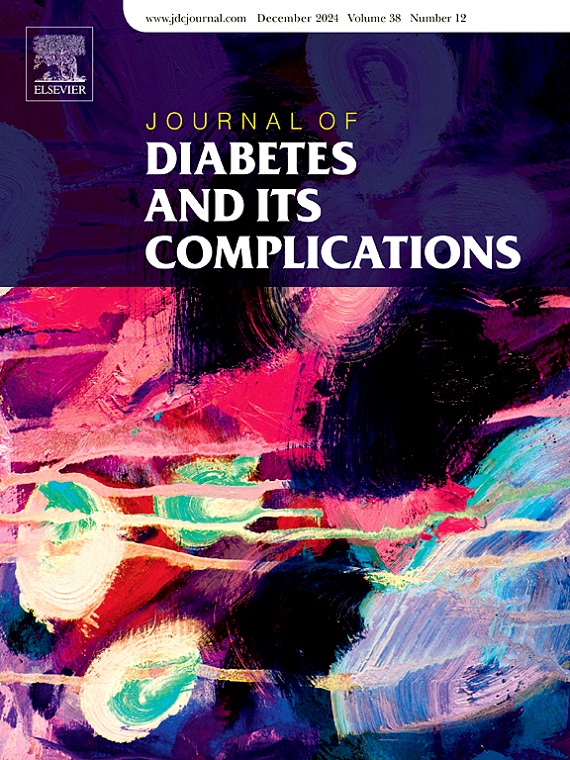左西替利嗪降低糖尿病肾病患者蛋白尿和炎症生物标志物的疗效:一项随机对照试验
IF 3.1
3区 医学
Q3 ENDOCRINOLOGY & METABOLISM
引用次数: 0
摘要
在全球范围内,糖尿病的患病率正在上升。糖尿病肾病(DN)是终末期肾病(ESRD)的主要原因之一,也是糖尿病患者发病率和死亡率较高的危险因素之一,有时也被称为糖尿病肾病(DKD)。DN是糖尿病的一种微血管后果,影响着全球20 - 40%的糖尿病患者。该研究的目的是评估左西替利嗪是否通过减少蛋白尿和改善DKD指标,在接受血管紧张素受体阻滞剂(ARBs)和钠-葡萄糖共转运蛋白2 (SGLT2)抑制剂治疗的患者中具有降低蛋白尿和抗炎作用。患者与方法对60例DKD患者进行对照、平行试验。60例患者随机分为两组。1组(对照组)在缬沙坦80 mg的基础上给予恩格列净10 mg, 1次/ d。第2组(左西替利嗪组)给予与对照组相同的药物治疗,另加5 mg左西替利嗪,每日1次,晚间1次,根据每位患者的肌酐清除率(CrCl)滴定剂量,持续3个月。在基线时测量血清肌酐、血清尿素、血清胱抑素c、HbA₁c、肿瘤坏死因子α (TNF-α)、肾小球滤过率(eGFR)和尿白蛋白/肌酐比(UACR),并与给药后三个月的数据进行比较。结果与对照组相比,左西替利嗪在3个月末显著降低UACR (p = 0.037)。两组间eGFR无差异,两组eGFR均显著低于基线(p < 0.001)。与对照组相比,左西替利嗪组TNF-α (p = 0.004)、胱抑素- c (p = 0.034)和HbA₁c (p = 0.007)均有显著下降。结论左西替利嗪可降低蛋白尿、炎症和肾脏指标,具有降低蛋白尿和抑制疾病进展的潜在抗炎药物作用。试验注册标识nct05638880本文章由计算机程序翻译,如有差异,请以英文原文为准。
Efficacy of levocetirizine in reducing albuminuria and inflammatory biomarkers in patients with diabetic kidney disease: A randomized controlled trial
Globally, the prevalence of diabetes mellitus is rising. One of the main causes of end-stage renal disease (ESRD) and a risk factor for higher morbidity and death in diabetic patients is diabetic nephropathy (DN), sometimes referred to as diabetic kidney disease (DKD). DN, a microvascular consequence of diabetes, affects 20–40 % of diabetics globally. The study's objective was to assess if levocetirizine may have albuminuria lowering effect and anti-inflammatory effect in patients treated with angiotensin receptor blockers (ARBs) and sodium-glucose cotransporter 2 (SGLT2) inhibitors therapy by reducing albuminuria and improving DKD indicators.
Patients and methods
A controlled, parallel, trial was carried out on sixty DKD patients. Sixty patients were divided into two groups at random. Group 1 (control group) received an empagliflozin 10 mg once day in addition to 80 mg valsartan. Group 2 (levocetirizine group) received the same medications as the control group plus a 5 mg of levocetirizine once daily in the evening, titrated dose based on each patient's creatinine clearance (CrCl) for three months. Serum creatinine, serum urea, serum cystatin-C, HbA₁c, tumor necrosis factor alpha (TNF-α), estimated glomerular filtration rate (eGFR), and urinary albumin to creatinine ratio (UACR) were measured at baseline and compared to these data three months after drug administration.
Results
Levocetirizine decreased significantly UACR at the end of the three-months (p = 0.037) compared to the control group. There was no variation in eGFR between the two groups, eGFR was significantly lower than baseline (p < 0.001) in both groups. Comparing the levocetirizine group to the control group, there is a substantial drop in TNF-α (p = 0.004), cystatin-C (p = 0.034), and HbA₁c (p = 0.007).
Conclusion
Levocetirizine reduces albuminuria, inflammatory, and renal indicators, which makes it a potentially has albuminuria lowering effect and anti-inflammatory drug which decreases disease progression.
Trial registration identifier
NCT05638880
求助全文
通过发布文献求助,成功后即可免费获取论文全文。
去求助
来源期刊

Journal of diabetes and its complications
医学-内分泌学与代谢
CiteScore
5.90
自引率
3.30%
发文量
153
审稿时长
16 days
期刊介绍:
Journal of Diabetes and Its Complications (JDC) is a journal for health care practitioners and researchers, that publishes original research about the pathogenesis, diagnosis and management of diabetes mellitus and its complications. JDC also publishes articles on physiological and molecular aspects of glucose homeostasis.
The primary purpose of JDC is to act as a source of information usable by diabetes practitioners and researchers to increase their knowledge about mechanisms of diabetes and complications development, and promote better management of people with diabetes who are at risk for those complications.
Manuscripts submitted to JDC can report any aspect of basic, translational or clinical research as well as epidemiology. Topics can range broadly from early prediabetes to late-stage complicated diabetes. Topics relevant to basic/translational reports include pancreatic islet dysfunction and insulin resistance, altered adipose tissue function in diabetes, altered neuronal control of glucose homeostasis and mechanisms of drug action. Topics relevant to diabetic complications include diabetic retinopathy, neuropathy and nephropathy; peripheral vascular disease and coronary heart disease; gastrointestinal disorders, renal failure and impotence; and hypertension and hyperlipidemia.
 求助内容:
求助内容: 应助结果提醒方式:
应助结果提醒方式:


